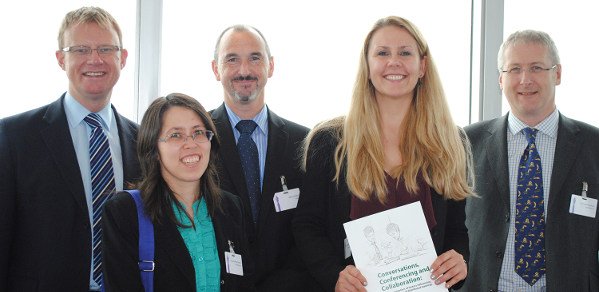
Dr Anna Mieczakowski, Dr Joy Goodman-Deane, Mr Jeff Patmore and Professor John Clarkson from the Cambridge Engineering Design Centre (EDC) launched two new UK and US public reports - Conversations, Conferencing and Collaboration: An international investigation of factors influencing the effectiveness of distributed meetings - on the 16th October 2013 at BT Tower in London and on the 22nd October in New York in the presence of the press and large global businesses.
Poor sound quality puts pressure on participants' hearing and thinking capabilities, which can result in tiredness and impair people's concentration and contributions to the meeting, as well as having a negative effect on secondary tasks such as note-taking. By improving the sound quality of a call, participants will be less stressed and less tired, and thus in a better position to clearly communicate their views and understand those of other attendees.
Dr Anna Mieczakowski
This BT/Dolby-sponsored research was conducted in four countries - UK, US, Australia and China - and used both qualitative and quantitative data collection methods to investigate professionals' use of conferencing systems. As part of the research, five multidisciplinary experts (from areas such as co-operative work, human hearing, human-computer interaction and management) and ten representatives of multi-sector organisations with extensive experience of teleconferencing were interviewed. An online survey with 100 professionals, in each of the four participating countries, was also conducted to generalise the findings. Notably, this research was aimed at identifying the key factors impacting on the effectiveness of conferencing meetings and distilling good practice recommendations.
The key findings from the UK and the US - published first - revealed that, according to 78% of UK respondents and 91% of US respondents, audio solutions are still the most frequently used conferencing technology. Furthermore, the two most significant factors of effective conferencing are reliable technology (81% for UK and 93% for US) and good sound quality (77% for UK and 96% for US). Focused participants were reported to be the third most prevalent factor in the UK with 72% of responses, while US's third most highly-rated factor was the ability to mute background noise with 84% of responses. Poor audio quality, in particular, was said to make it hard to understand who is speaking, what is being said and in what emotional tone. This, in turn, was reported to lead to increased fatigue levels for participants and decreased productivity.
Dr Anna Mieczakowski, who led this research, said: "Poor sound quality puts pressure on participants' hearing and thinking capabilities, which can result in tiredness and impair people's concentration and contributions to the meeting, as well as having a negative effect on secondary tasks such as note-taking. By improving the sound quality of a call, participants will be less stressed and less tired, and thus in a better position to clearly communicate their views and understand those of other attendees".
Among other major challenges to successful conferencing reported in the study were: (1) difficulties in speaker identification; (2) difficulties in making oneself heard; and (3) the challenge of creating a good social experience. Cost, the effort required in integrating and learning a new system and security issues were also perceived to be the key barriers to adoption of new conferencing technologies in both countries.
The good-practice principles, relating to both the Technology and the People aspects of conferencing, that this research proposes for UK and US conferencing are:
- Technology: Use high-quality communication technology
The technology used in a distributed meeting has a large impact on its effectiveness. Poor technology can make meetings ineffective and waste the valuable time of the participants and company money. Technology should provide high quality sound, be reliable and be easy-to-use. - Management: Employ effective management approaches
The way in which a project and an individual meeting are managed has a big impact on meeting effectiveness. Good management can help teams to work well together, cover the important points and make efficient decisions. - Team behaviour: Encourage good team behaviour
The behaviour of people participating in a distributed meeting can improve, or detract, from that meeting. This has implications for team work and individual behaviour, both within a particular meeting and across a project more generally.
This study also provides specific recommendations based around these principles for all stakeholders of conferencing meetings - Organisations, Chairpeople and Participants.
Ultimately, a combination of Technology and People factors - using high quality communication technology, employing effective management approaches and encouraging good team behaviour - can achieve greater productivity in distributed meetings for all participants.
For more details and to download the pdf and ebook versions of the UK and US reports, see http://www-edc.eng.cam.ac.uk/teleconferencing/
*The launches of the studies from Australia and China will take place in early 2014.

